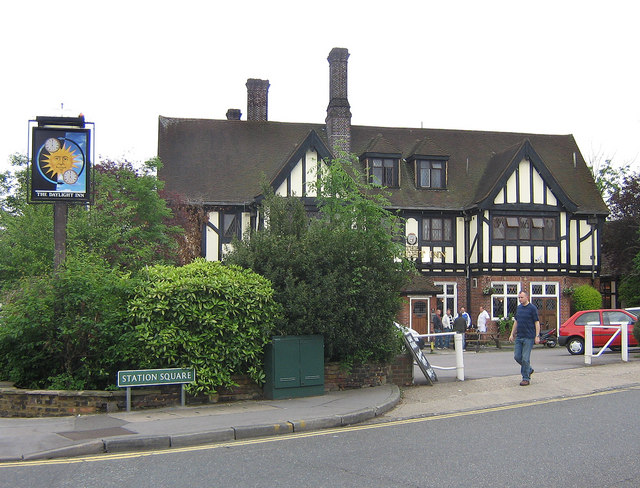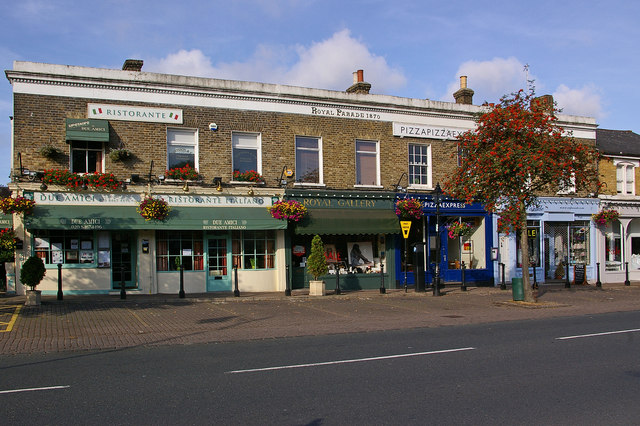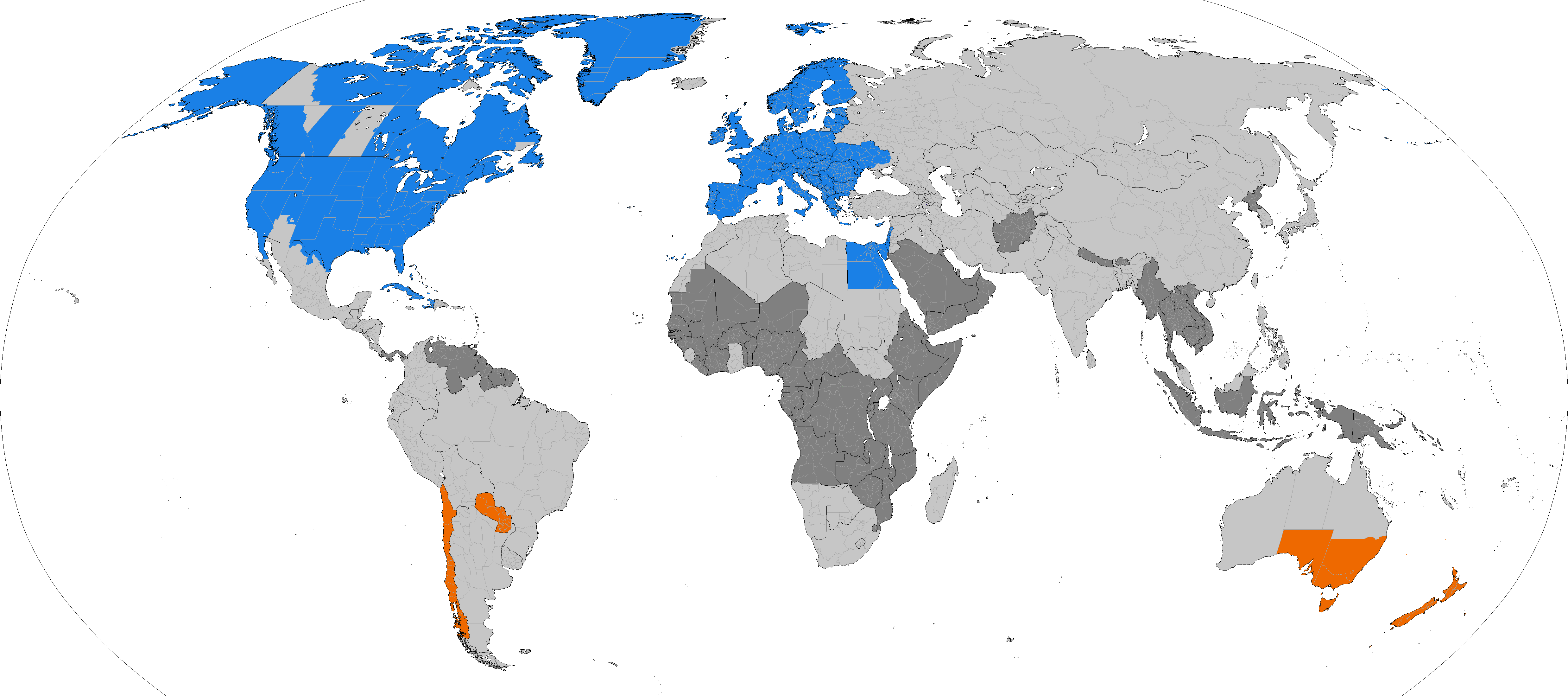|
Derwent House
Derwent House, on Camden Park Road, Chislehurst, Bromley, is one of a number of the locally renowned 'Willett-built' houses erected on the Camden Park Estate by high-class speculative builder William Willett in the 1900s. Willett bought the entire estate in 1890 with the intention of building on it all but the venture was not successful and he erected only a small number of houses there and on Wilderness Road. The remainder of the estate became the Chislehurst Golf Club with the mansion, Camden Place, becoming its clubhouse. Derwent House was erected in 1899. The design is inspired by the arts and crafts movement. It is of red brick in with a red clay tiled roof. It was designed by Ernest Newton and a ballroom was added in 1903 by Amos Faulkner (Willett's in-house architect). Faulkner also designed the detached motor house with carriage-wash canopy. Derwent is a Grade II listed building located within the Chislehurst Conservation Area. Willett lived in a similar Newton ho ... [...More Info...] [...Related Items...] OR: [Wikipedia] [Google] [Baidu] |
Ernest Newton
Ernest Newton (12 September 1856 – 25 January 1922) was an English architect, President of Royal Institute of British Architects and founding member of the Art Workers' Guild. Life Newton was the son of an estate manager of Bickley, Kent. He was educated at Uppingham School. He married, in 1881, Antoinette Johanna Hoyack, of Rotterdam, and had three sons. He was resident again at Bickley in 1883 and built his own house at Bird in Hand Lane, Bickley in 1884. In the next 20 years he built many houses in the Bickley and Chislehurst area – no two being identical. Career He served his apprenticeship in the office of Richard Norman Shaw from 1873 to 1876, remaining for a further three years as an assistant before commencing private practice on his own account in London in February 1880. He was briefly in partnership with William West Neve around 1882. In 1884, he was a founder member of the Art Workers Guild. He developed a career designing one-off houses largely in ... [...More Info...] [...Related Items...] OR: [Wikipedia] [Google] [Baidu] |
William Willett
William Willett (10 August 1856 – 4 March 1915) was a British builder and a promoter of British Summer Time. Biography Willett was born in Farnham, Surrey, and educated at the Philological School. After some commercial experience, he entered his father's building business, Willett Building Services. Between them they created a reputation for "Willett built" quality houses in choice parts of London and the south, including Chelsea and Hove, including Derwent House. He lived most of his life in Chislehurst, Kent, where, it is said, after riding his horse in Petts Wood near his home early one summer morning and noticing how many blinds were still down, the idea for daylight saving time first occurred to him. This was not the first time that the idea of adapting to daylight hours had been mooted, however. It was common practice in the ancient world, and in 1784 a light-hearted satire by Benjamin Franklin resulted in resurrecting the idea. Although Franklin's suggestion was s ... [...More Info...] [...Related Items...] OR: [Wikipedia] [Google] [Baidu] |
Chislehurst
Chislehurst () is a suburban district of south-east London, England, in the London Borough of Bromley. It lies east of Bromley, south-west of Sidcup and north-west of Orpington, south-east of Charing Cross. Before the creation of Greater London in 1965, it was in Kent. History The name "Chislehurst" is derived from the Old English language, Saxon words ''cisel'', "gravel", and ''hyrst'', "wooded hill". The Walsingham family, including Christopher Marlowe's patron, Thomas Walsingham (literary patron), Sir Thomas Walsingham and Elizabeth I of England, Queen Elizabeth I's spymaster, Francis Walsingham, had a home in Scadbury Park, now a nature reserve in which the ruins of the house can still be seen. A water tower used to straddle the road from Chislehurst to Bromley until it was demolished in 1963 as one of the last acts of the Chislehurst and Sidcup UDC. It marked the entrance to the Wythes Estate in Bickley, but its narrow archway meant that double-decker buses were not ... [...More Info...] [...Related Items...] OR: [Wikipedia] [Google] [Baidu] |
Bromley
Bromley is a large town in Greater London, England, within the London Borough of Bromley. It is south-east of Charing Cross, and had an estimated population of 87,889 as of 2011. Originally part of Kent, Bromley became a market town, chartered in 1158. Its location on a coaching route and the opening of a railway station in 1858 were key to its development and the shift from an agrarian village to an urban town. As part of the suburban growth of London in the 20th century, Bromley significantly increased in population and was Municipal Borough of Bromley, incorporated as a municipal borough in 1903 and became part of the London Borough of Bromley in 1965. Bromley today forms a major retail and commercial centre. It is identified in the London Plan as one of the 13 metropolitan centres of Greater London. History Bromley is first recorded in an Anglo-Saxon charter of 862 as ''Bromleag'' and means 'woodland clearing where Cytisus scoparius, broom grows'. It shares this Old ... [...More Info...] [...Related Items...] OR: [Wikipedia] [Google] [Baidu] |
Amos Faulkner
Amos or AMOS may refer to: Arts and entertainment * Amos Records, an independent record label established in Los Angeles, California, in 1968 * Amos (band), an American Christian rock band * ''Amos'' (album), an album by Michael Ray * ''Amos'' (film), a 1985 American made-for-television drama film People and religious figures * Amos (name), a given name, nickname and surname Technology * AMOS or Advanced Mortar System, a 120 mm automatic twin barreled, breech loaded mortar turret * AMOS (programming language), a dialect of BASIC on the Amiga computer * Alpha Micro Operating System, a proprietary operating system used in Alpha Microsystems minicomputers * AMOS (statistical software package), a statistical software package used in structural equation modeling * Air Force Maui Optical and Supercomputing observatory, an Air Force Research Laboratory operating on Maui, Hawaii * Amos (satellite), series of Israeli IAI-built civilian communications satellites ** AMOS (s ... [...More Info...] [...Related Items...] OR: [Wikipedia] [Google] [Baidu] |
Listed Building
In the United Kingdom, a listed building or listed structure is one that has been placed on one of the four statutory lists maintained by Historic England in England, Historic Environment Scotland in Scotland, in Wales, and the Northern Ireland Environment Agency in Northern Ireland. The term has also been used in the Republic of Ireland, where buildings are protected under the Planning and Development Act 2000. The statutory term in Ireland is " protected structure". A listed building may not be demolished, extended, or altered without special permission from the local planning authority, which typically consults the relevant central government agency, particularly for significant alterations to the more notable listed buildings. In England and Wales, a national amenity society must be notified of any work to a listed building which involves any element of demolition. Exemption from secular listed building control is provided for some buildings in current use for worship, ... [...More Info...] [...Related Items...] OR: [Wikipedia] [Google] [Baidu] |
Daylight Saving Time
Daylight saving time (DST), also referred to as daylight savings time or simply daylight time (United States, Canada, and Australia), and summer time (United Kingdom, European Union, and others), is the practice of advancing clocks (typically by one hour) during warmer months so that darkness falls at a later clock time. The typical implementation of DST is to set clocks forward by one hour in the spring ("spring forward"), and to set clocks back by one hour in the fall ("fall back") to return to standard time. As a result, there is one 23-hour day in early spring and one 25-hour day in the middle of autumn. The idea of aligning waking hours to daylight hours to conserve candles was first proposed in 1784 by U.S. polymath Benjamin Franklin. In a satirical letter to the editor of ''The Journal of Paris'', Franklin suggested that waking up earlier in the summer would economize on candle usage; and calculated considerable savings. In 1895, New Zealand entomologist and astronome ... [...More Info...] [...Related Items...] OR: [Wikipedia] [Google] [Baidu] |
Houses In The London Borough Of Bromley
A house is a single-unit residential building. It may range in complexity from a rudimentary hut to a complex structure of wood, masonry, concrete or other material, outfitted with plumbing, electrical, and heating, ventilation, and air conditioning systems.Schoenauer, Norbert (2000). ''6,000 Years of Housing'' (rev. ed.) (New York: W.W. Norton & Company). Houses use a range of different roofing systems to keep precipitation such as rain from getting into the dwelling space. Houses may have doors or locks to secure the dwelling space and protect its inhabitants and contents from burglars or other trespassers. Most conventional modern houses in Western cultures will contain one or more bedrooms and bathrooms, a kitchen or cooking area, and a living room. A house may have a separate dining room, or the eating area may be integrated into another room. Some large houses in North America have a recreation room. In traditional agriculture-oriented societies, domestic animals such ... [...More Info...] [...Related Items...] OR: [Wikipedia] [Google] [Baidu] |



.jpg)


